
* Before World War II, the North American Aviation company developed a series of trainers, starting with the "BT-9", which ultimately evolved into the "AT-6 Texan". The Texan proved very popular with Allied air forces, with over 10,000 built. This document provides a history and description of the Texan -- as well as its Australian derivatives, the "Wirraway" and the "Boomerang". A list of illustration credits is given at the end.
* The North American Aviation (NAA) Company was established in 1928 as a holding company for a number of American aviation firms, including Curtiss, Sperry, and Trans-World Airlines. In 1933, North American was re-organized into a full-fledged aviation company of its own, with the president being James H. "Dutch" Kindelberger, and the chief engineer being John Leland "Lee" Atwood. They had both been engineers at Douglas Aircraft company.
The first aircraft turned out by NAA was the "GA-15" -- the "GA" standing for "General Aircraft Corporation", which was the name of the NAA manufacturing arm at the outset. The GA-15 was a three-seat observation aircraft, obtained by the US Army Air Corps as the "O-47", produced by a plant in Dandalk, Maryland. That exercise going well, Kindelberger and Atwood decided to come up with a design for the 1934 Army Basic Trainer competition, with the "NA-16" prototype performing its initial flight on 1 April 1935, with company test pilot Eddie Allen at the controls.
The NA-16 was a low-wing monoplane with fixed taildragger landing gear. The fuselage was made of steel tubing, covered with fabric. That was traditional construction at the time, but the NA-16 was innovative in that the fuselage was modularly-designed -- made up of sub-assemblies that could be produced independently, then bolted together. It also had access panels that eased servicing of aircraft.
The NA-16's wings and tail surfaces were of all-metal construction, except for fabric-covered control surfaces. Control surface arrangement was conventional, with ailerons, flaps, elevators, rudder, and trim tabs -- all manually controlled. There were three flaps, one spanning across the belly into the inner wings, one on each wing; they were "split" flaps, meaning they were mounted underneath the rear of the wing, instead of behind it. The wing resembled a scaled-down version of the wing of the Douglas DC-2, which Kindelberger and Atwood had worked on while at Douglas. The NA-16 was powered by a nine-cylinder air-cooled Wright R-975-E3 Whirlwind radial engine, with 310 kW (420 HP), driving a two-bladed propeller.
The NA-16 easily won the Army Basic Trainer competition, though of course the Army required changes, including a fully-enclosed cockpit with a sliding canopy -- the front part of the canopy sliding back over the fixed midsection, the rear part of the canopy sliding forward under the midsection -- plus fairings / pants on the main landing gear, along with a larger carburetor intake above and behind the engine.
The NA-16 prototype was modified accordingly, to become the "NA-18", with the company also altering it so it could be re-engined with a Pratt & Whitney (PW) nine-cylinder air-cooled R-1340 Wasp radial engine, as well as provisions for armament of three 7.62-millimeter (0.30 caliber) Browning machine guns -- two in the cowling, plus a flexibly-mounted gun in the rear cockpit. These features were added to make the design more attractive to other customers.
The Army ordered 42 under the designation of "Basic Trainer Model 9 (BT-9)", or "NA-19". North American didn't have the production capacity in Maryland to handle that kind of volume, so the company relocated to Inglewood, California, to take up residence in a much bigger plant. Deliveries of the BT-9 to the Army Air Corps began in the spring of 1936.
While the NA-18 prototype had featured a flat-top canopy, the NA-19 production machines had a canopy with a rounded top to provide more headspace. The engine was switched to the slightly less powerful R-975-7 Whirlwind variant, with 300 kW (400 HP). After low-speed handling problems were uncovered, a leading-edge slat was fitted to each outer wing.
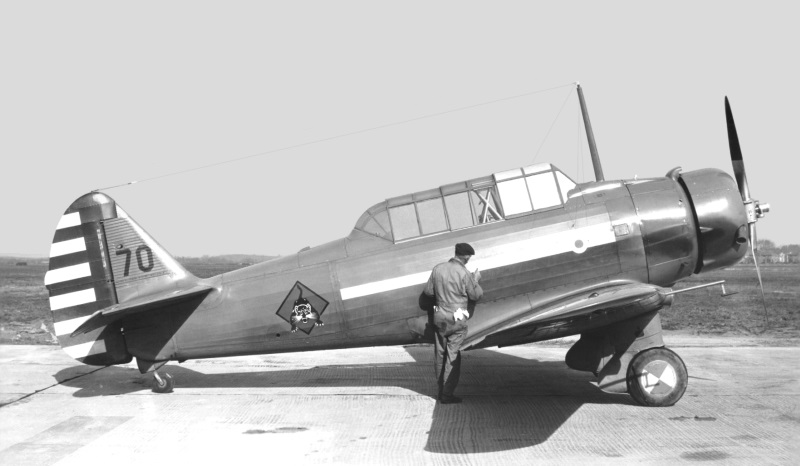
The 42 BT-9s were followed by an order for 40 "BT-9A" AKA "NA-19A" machines, with the armament option -- one gun in the cowling, aimed by a telescopic sight, plus the rear gun -- and the fuselage stretched by 13 centimeters (5 inches). It appears the guns were specified for armament training, and not necessarily always fitted. The leading-edge slats, having proven unsatisfactory, were replaced in later BT-9A production by a modified outer wing with an altered leading edge profile.
The BT-9A was followed by 117 "BT-9B" AKA "NA-23" machines, which were much the same, except for being unarmed; and then 67 "BT-9C" AKA "NA-29" machines, with minor tweaks, intended for use by the air reserve. The Air Corps also evaluated a single "NA-22" machine that was powered by a Wright R-760ET Whirlwind with 170 kW (225 HP). It was dangerously underpowered; it is unclear what the point of it was, and it was resoundingly rejected by the Air Corps.
In response to a US Navy (USN) requirement for a trainer, NAA altered a BT-9C machine to use a PW R-1340-6 Wasp engine, with 375 kW (500 HP). The Navy didn't like the Whirlwind powerplant, because it wasn't in their inventory. This aircraft was given the company designation of "NA-28" and the Army designation of "Y1BT-10". There were plans to produce it as the "BT-10" AKA "NA-30", but it didn't happen.
The NA-28 proving satisfactory, the Navy ordered 40 as the "NJ-1" -- where, somehow, "N" and "J" stood for "trainer" and "North American" respectively. Initial deliveries of the NJ-1 were in the summer of 1937. They could be distinguished from the BT-9 by the fact that the carburetor intake was repositioned to the bottom lip of the cowling, and there were two exhaust stacks instead of one.
* Following the NJ-1, NAA engineers rethought the design, resulting in the "NA-58", initially designated the "BT-9D". It replaced the tube / fabric fuselage with an all-metal fuselage, stretched by 36 centimeters (14 inches). The wings were modified, with a wider chord, squared-off wingtips, and reduced span; while the rounded rudder was traded for one with an angled trailing edge, giving the tailfin assembly a triangular appearance. The flight control surfaces were still fabric-covered. It was powered by an air-cooled, 9-cylinder PW R-985-25 Wasp Junior radial, with 335 kW (450 HP). The engine was in a bigger cowling.
The first example, redesignated the "YBT-14", performed its initial flight on 10 February 1938. It was evaluated by the Army, which was impressed enough to order 251 production "BT-14" machines. Later, in 1941, 27 of the BT-14s were re-engined with the R-985-11A engine, providing 300 kW (400 HP), being redesignated "BT-14A".
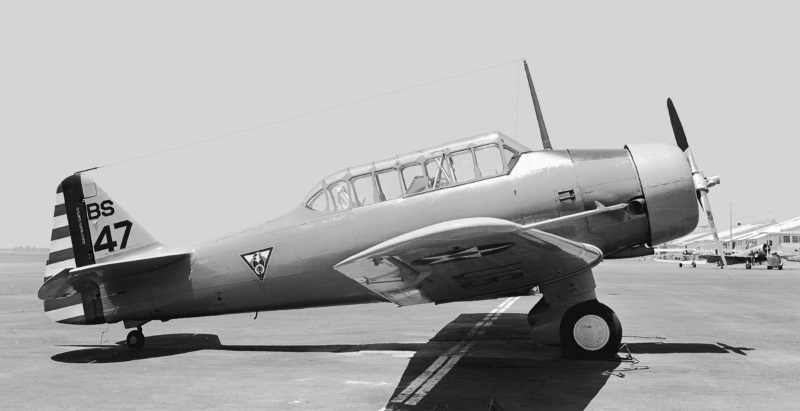
World War II having broken out in 1939, export orders came in for the North American BT series:
Vichy France and the Germans made use of the NA-57 and NA-64 machines well into the war, while the Yales remained in service with RCAF and British Royal Air Force (RAF) training units in Canada through the war.
BACK_TO_TOP* Even before the flight of the BT-14, NAA engineers were working on the addition of retractable landing gear to the BT series. NAA proposed the concept to the military, but for the moment, there was not so much military interest in trainers. Dutch Kindelberger informed the Air Corps that the type could be armed, and proposed the new version as a "Basic Combat (BC)" machine. That sounds like pure salesmanship, but the Air Corps was agreeable.
The prototype of the "NA-36" or "BC-1" took to the air on 11 February 1938, with 180 production machines ordered. It was much like a BT-9C -- it doesn't seem any were actually delivered with weapons -- with the tube / fabric fuselage, and the older wing configuration with rounded tips. The rudder was still rounded off, but only at the top, otherwise having a straight trailing edge to provide more area and control authority.
The landing gear hydraulically retracted in from the wings towards the fuselage. It was powered by a PW R-1340-47 Wasp radial with 410 kW (550 HP). Although the aircraft's weight increased, the more powerful engine and the retractable landing gear increased speed by about 10%. 36 of the BC-1s were configured as instrument trainers, and redesignated "BC-1I".
The British liked the BC-1, and ordered the type, modified to British spec, as the "Harvard Mark I" for the British Royal Air Force (RAF). The Harvard I, which has the company designation of "NA-49", only differed from the BC-1 in having British instruments and radios, a British ring-type control-stick grip, provision for a single 7.7-millimeter (0.303-caliber) Vickers machine gun in the right wing, and a PW R-1340-S3H1 radial with 445 kW (600 HP). The first was delivered to Britain in late 1938, with a total of 430 obtained in all -- 30 of them for the Royal Canadian Air Force (RCAF), these machines having the company designation of "NA-61". A variation on the BC-1 was also license-built in Australia as the "Wirraway", of which more is said later.
In the fall of 1938, the USN issued a requirement for a training aircraft to get aircrews up to speed on new high-performance scout aircraft, with NAA responding with the "NA-52" or "SNJ-1". It was a hybrid of the BT-14 and the BC-1, with the BT-14's all-metal fuselage and new wing, plus the retractable landing gear and round-top rudder of the BC-1. It was powered by a PW R-1340-6 Wasp radial with 400 kw (500 HP), the Navy not seeing the need for the more powerful R-1340-47 radial. 16 SNJ-1s were obtained.
The Navy decided a more powerful engine would be nice anyway, and so ordered 36 "SNJ-2" AKA "NA-65" machines, with a PW R-1340-36 engine, with 445 kW (600 HP). 25 more were ordered later, with the company designation of "NA-79". Other than minor changes to the engine installation, the SNJ-2 was hard to tell from an SNJ-1.
The Army liked the configuration of the SNJ-1/2, the result being the "BC-2" AKA "NA-54", with three obtained for evaluation. They were powered by an R-1340-45 Wasp radial with 445 kW (600 HP), driving a three-bladed propeller. The carburetor intake was repositioned under the nose of the aircraft, behind the cowling. That led to a production of 83 similar "BC-1A" AKA "NA-55" machines, with the slightly tweaked -47 or -49 Wasp variants, and a two-bladed prop, the three-bladed prop having demonstrated no advantage. They were purchased for air reserve use.
After initial deliveries, the Army decided the "BC" designation didn't really make much sense after all, and so the BC-1A was followed by the "AT-6" AKA "NA-59", with "AT" standing for "advanced trainer", with 94 obtained.
Britain also obtained "Harvard II" trainers based on the BC-1A / AT-6, but with modifications similar to those of the Harvard I -- along with a cockpit heater, wrapped around the exhaust pipe, which was apparently refitted to Harvard Is. The order history is complicated:
* North American sold a two-seat fighter-attack version of the AT-6, with the company designation of "NA-44". It was powered by a Wright R-1820-52 Cyclone radial with 585 kW (785 HP), driving a three-bladed variable-pitch propeller. It was armed with five 7.62-millimeter Browning machine guns, with two in the cowling, one in each wing, and one on a flexible mount in the rear cockpit. It had underwing racks for a total of 180 kilograms (400 pounds) of bombs, and a centerline rack for a bomb up to 225 kilograms (500 pounds) in size.
A number of NA-44s were sold, including one to the RCAF for evaluation; ten to Siam (Thailand) as the "NA-69"; 30 to Brazil as the "NA-72"; and 12 to Chile as the "NA-74". Hostilities between Siam and French Indochina following the fall of France in the spring of 1940 led to a US arms embargo against Siam, with the NA-69s held while in transit through the Philippines. They were taken over by the USAAC, and used as trainers under the designation of "A-27". They were all lost in the course of the Japanese assault on the Philippines from 8 December 1941.
North American also sold a single-seat fighter derivative of the AT-6, the "NA-50", which had the fuselage shortened by 30 centimeters (a foot) and the wingspan trimmed by 1.5 meters (5 feet). It had a single-seat cockpit in a "razorback" configuration, with a rounded-top rudder. The NA-50 was powered by a Wright R-1820-77 radial with 650 kW (870 HP), driving a three-bladed propeller, and had armament of four 7.62-millimeter Brownings -- two in the cowling, one in each wing -- aimed by a telescopic gunsight. They could carry up to 250 kilograms (550 pounds) of bombs on underwing racks.
Peru bought seven, with deliveries in 1938-1939, and two lost in a border clash with Ecuador in 1941. Siam evaluated an NA-50, to request changes that resulted in the "NA-68", which differed from the NA-50 in being fitted with four 8-millimeter machine guns, instead of the four 7.62-millimeter machine guns; a single 20-millimeter cannon in a gondola outboard in each wing; the triangular tail of the AT-6; and the telescopic gunsight replaced by some class of gunsight inside the cockpit.
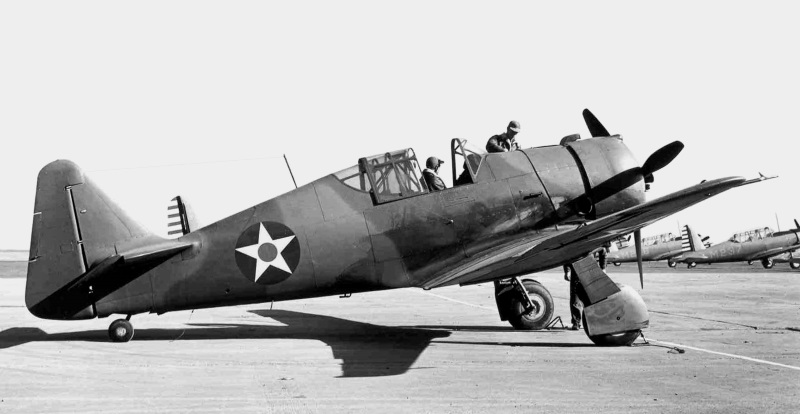
Six were ordered by Siam, but they were also embargoed; they were shipped back to California from the Philippines, stripped of armament, and used as advanced trainers under the designation of "P-64". One has survived to the present, being in the possession of the Experimental Aircraft Association in Oshkosh, Wisconsin. North American didn't build another single-seat fighter version of the AT-6 -- but as discussed later, that wasn't the end of the idea.
* As a footnote, there were a large number of Texan variants during the early evolution of the type that were built in single quantities or in small lots, and about which little is known. They included the:
* Following the AT-6, the Air Corps moved on to the "NA-77" AKA "AT-6A". It was much like the AT-6, but had redesigned instrument panels, a redesigned canopy, and an R-1340-49 Wasp radial with 445 kW (600 HP), just like the -45 engine of the AT-6. With the AT-6, the design had stabilized, and all the versions from then on would be hard to tell from each other. 637 NA-77s were obtained.
The AT-6A retained the armament option of two 7.62-millimeter Brownings for weapons training, including a gun in the cowling and a rear gun on a flexible mount. The rear seat was able to pivot around to allow the back-seater to use of the rear Browning. Deliveries to the US Army Air Forces -- USAAF, which superseded the Air Corps in June 1941 -- during 1941.
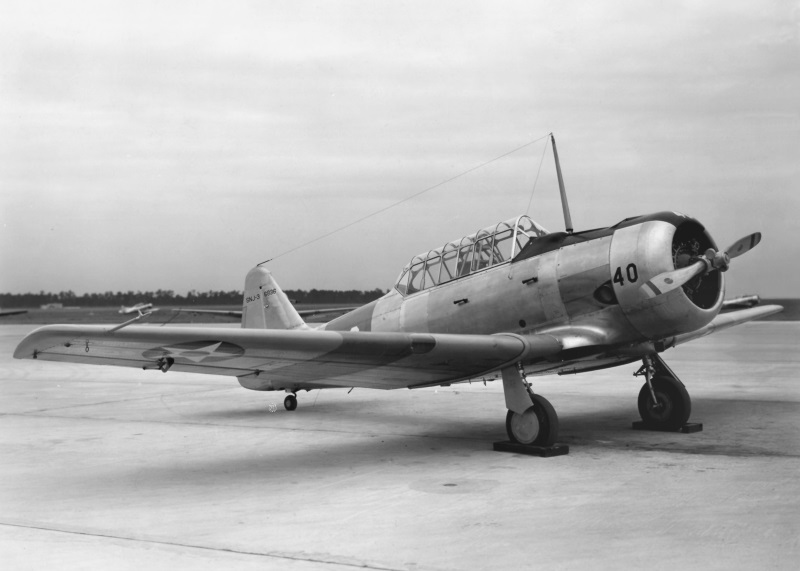
The Navy obtained effectively the same aircraft as the "SNJ-3" AKA "NA-78". It had minor tweaks relative to the AT-6A, most notably an R-1340-AN-1 Wasp engine, very similar to the -49 variant, but with modifications to Navy spec. 568 NA-78s were obtained -- it must be noted, however, that each of the NA-77 and NA-78 product batches may have included both USAAF AT-6As and USN SNJ-3s, with some of the machines possibly provided to foreign users. This is a core confusion in the Texan history: different military variants, it seems, could sometimes have the same NAA model number, and different NAA models could sometimes be the same military variant.
In any case, the Navy obtained 120 NA-78 machines, with a number converted by the Navy to "SNJ-3C" carrier landing trainers, fitted with an arresting hook forward of the tailwheel.
With production ramping up, North American had to set up a new factory in Dallas, Texas, dedicated to producing the trainers, with the great majority of them built in Texas from then on. This was the origin of the name "Texan" for the type -- for convenience, the entire line of aircraft, back to the BT-9, is referred to here as the "Texan family", though the name wasn't used for the earlier models. Machines built in Inglewood would have a "-NA" suffix, while those built in Dallas would have an "-NT" suffix -- though the suffix is ignored here.
A variation on the AT-6A, with British-specified tweaks, was built by the Noordyun Company of Montreal, Canada, with these machines designated "Harvard IIB", with 2,557 built. 42 of them were kitted up to haul target sleeves, and redesignated "Harvard TT.IIB". 1,800 of the Harvard IIBs were obtained by the USAAF for distribution to US allies under the Lend-Lease military assistance program, with these machines designated "AT-16" for paperwork purposes.
* The USAAF decided to standardize on the -AN-1 engine, resulting in the "AT-6B" AKA "NA-84". It also had a second forward-firing gun, in the starboard wing, and could haul four 45-kilogram (100-pound) bombs under the wing center section. The rear seat was fixed to face backwards, the AT-6B being intended for gunnery training. 400 were obtained.
There was no Navy equivalent to the AT-6B -- but the next variant, the "AT-6C", was obtained by the Navy as the "SNJ-4", both having the company designation of "NA-88". Initial deliveries were in June 1942, with 9,331 built. At the outset, the differences between the AT-6B and AT-6C were very minor and hard to notice. However, in response to a directive from the War Department to conserve on aluminum, wooden parts were increasingly introduced into production, with later production having a rear fuselage made of wood.
The wood rear fuselage was very strong, though it could suffer from rot in hot damp climates. It added to the airframe weight, but didn't seem to impair performance in any noticeable way. Britain also obtained the NA-88, as the "Harvard IIA'. Roughly half of the total production had wooden rear fuselages. The Navy converted a number of all-metal SNJ-4s to carrier trainers by adding an arresting hook, being redesignated "SNJ-4C".
The AT-6C led inevitably to the "AT-6D". Initial deliveries were in the summer of 1943. The only major difference between the AT-6D and the AT-6C was that the AT-6D introduced a 24-volt electrical system, compared to the 12-volt system of earlier models. Although some early production had wooden rear fuselages, most had all-metal fuselages, the aluminum shortage not having materialized.
The Navy obtained the AT-6D as the "SNJ-5", with a number converted to carrier-landing trainers as the "SNJ-5C". Early AT-6Ds were built as part of the NA-88 batch, and are included with the NA-88 production number; but later production had the "NA-121" model number, with 4,378 built. There were also 81 AT-6Ds for Brazil with the model number of "NA-119", 20 of them built under license in Brazil.
___________________________________________________________________
NORTH AMERICAN SNJ-5:
___________________________________________________________________
wingspan:
12.81 meters (42 feet)
wing area:
23.57 sq_meters (253.7 sq_feet)
length:
8.99 meters (29 feet 6 inches)
height:
3.58 meters (11 feet 9 inches)
empty weight:
1,885 kilograms (4,160 pounds)
MTO weight:
2,405 kilograms (5,300 pounds)
max speed:
330 KPH (205 MPH / 180 KT)
service ceiling:
6,550 meters (21,500 feet)
range:
1,205 kilometers (750 MI / 650 NMI)
___________________________________________________________________
One AT-6D was fitted with a Ranger V-770-9 air-cooled inverted vee-12 engine with 430 kW (575 HP) and redesignated "XAT-6E". The Ranger engine was seen as an alternative powerplant if Wasp production became problematic. Performance was substantially improved, but Wasp availability was never a problem, while the Ranger engine was unreliable. The XAT-6E actually flew in postwar air races, however. There are unconfirmed tales of a second conversion.
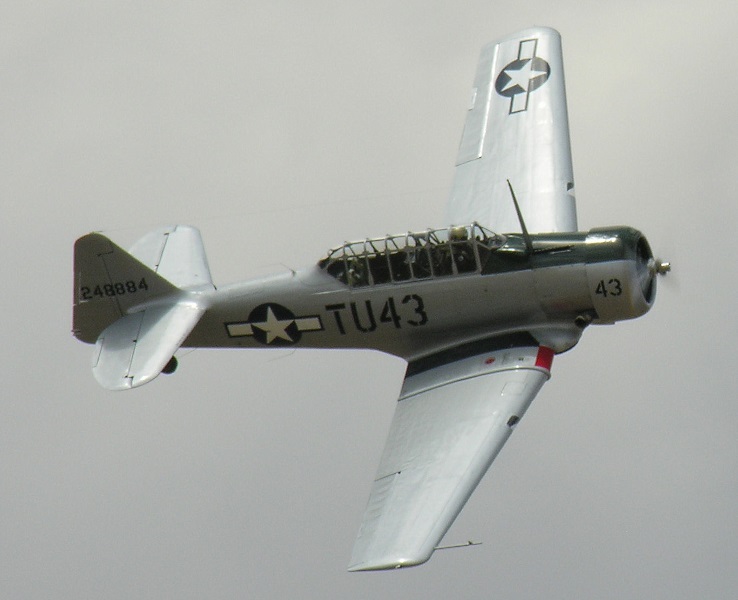
The last production variant of the Texan was the "AT-6F", which eliminated all provisions for armament, with the rear seat fixed to face forward, and the canopy appropriately simplified. It could carry a centerline drop tank with a capacity of 76 liters (20 US gallons). A prominent prop spinner was fitted, though it was often removed in the field, since it complicated maintenance and had no particular benefit. It retained the NA-121 model number, with production quantities included in the NA-121 total.
Total production quantity of the Texan family from US and license manufacture tallies to 23,942 machines, as determined by adding up model number production. This is not a very reliable number, with some sources giving over 17,000, others much less than that, one of the problems being "double counting" of production lots. As far as the number of aircraft operated by each user of the type, that's even more hopeless, particularly because aircraft tended to change hands. It might be best said that there were comparable quantities of USAAF AT-6s, Navy SNJs, and Commonwealth Harvards, with a lesser component of production supplied to everyone else.
BACK_TO_TOP* Although most combat aircraft that served in World War 2 were obsolete by the end of the conflict and were generally scrapped, the Texan was still a perfectly useful trainer, and large numbers of them survived. They became standard trainers for Western nations in the early years of the Cold War. When the US Air Force was established in 1947, the AT-6s in inventory were given the new designation of "T-6".
From 1949 to 1952, Texans were updated to "T-6G" configuration, with an improved cockpit layout, more fuel capacity, a steerable tailwheel, updated radios, and an R-1340-AN-1 radial engine with 445 kW (600 HP). They could be identified by their simplified canopy framing, and often had a fairing for a direction-finder antenna on top of the rear fuselage. There were several conversion series, with the company designations of "NA-168", "NA-182", "NA-188", "NA-195", and "NA-197", with quantities of 109 + 824 + 107 + 11 + 110 respectively, for a total of 1,161 conversions.
Some of these conversions were obtained by the US Navy, being redesignated "SNJ-7". Canadian Car & Foundry produced new-build T-6Gs, with 285 produced for the USAF, plus 270 for the RCAF, for a total of 555. There was talk of some production for the US Navy as the "SNJ-8" AKA "NA-198" -- but it didn't happen.
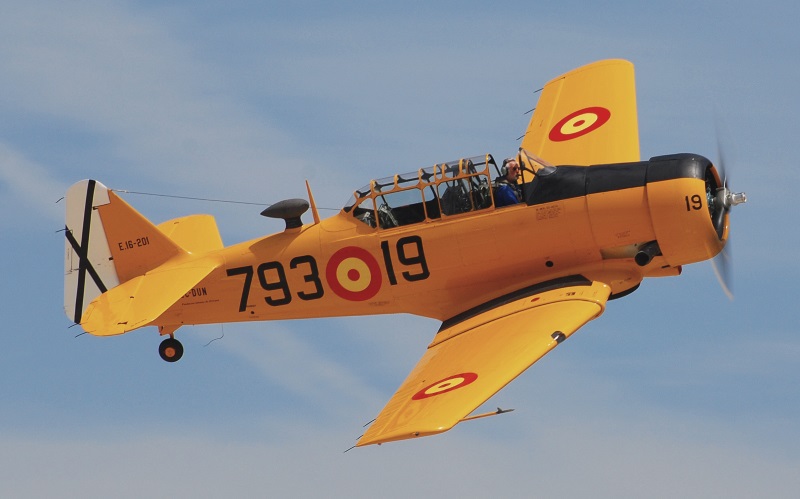
97 T-6Gs were modified for battlefield surveillance and forward air controller duties, carrying smoke rockets for target marking. The variant saw action in the Korean War, being nicknamed the "Mosquito". Interestingly, one T-6 in service during the Korean War was damaged in a crash, to be rebuilt as a floatplane -- that apparently being the only Texan seaplane. Armed Texans also saw combat in a number of other conflicts during the early Cold War period:
By the end of the 1950s, the Texan had been phased out of US military service, to end up on the civilian market. One was fitted out by the Bacon company with a bubble canopy, wingtip fuel tanks, and tricycle landing gear. More famously, a number of Texans were rebuilt to impersonate Japanese Mitsubishi Zero fighters, to star in the 1970 movie TORA TORA TORA, with some Texans also more extensively modified to stand in for Nakajima B5N torpedo bombers. These dummy Japanese warplanes still often perform in movies and at airshows.
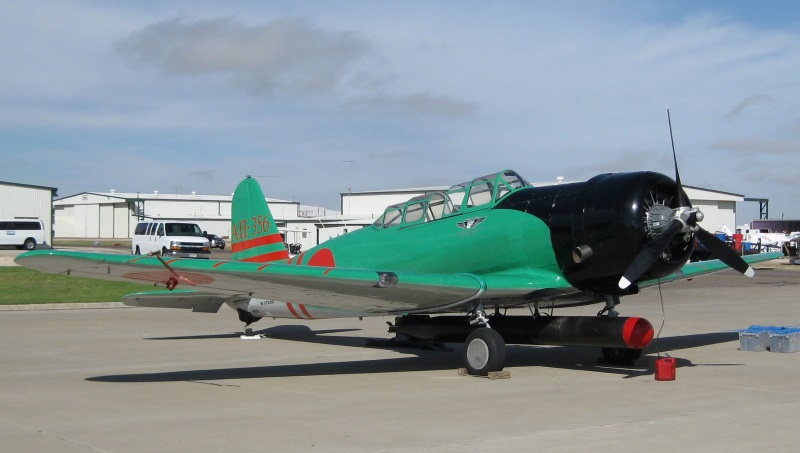
Indeed, the Texan remains a common performer at airshows, the type being sturdy, reliable, and apparently very pleasant to fly. They will continue to fly for decades more.
BACK_TO_TOP* Aside from Canadian and Brazilian production, there was other license manufacture of the Texan-family machines. One BT-9C, powered by a Wright R-975-7 Whirlwind providing 310 kW (420 HP), that was provided to Sweden as the "NA-31" as a pattern aircraft for evaluation and consideration for license production. It was followed by a single, similar "NA-38".
SAAB of Sweden built a total of 136 from 1937 to 1946 for the Flygvapnet, the Swedish Air Force, with the type being designated "Sk 14", "Sk" standing for "Skol (trainer)". With the coming of war, Sweden was cut off from the supply of Wright engines, and so later production was built with the Italian Piaggio P.VIIc seven-cylinder radial engine with 375 kW (500 HP), these machines were designated "Sk 14A". These aircraft could be fitted with ski landing gear, which was easy to do with the fixed landing gear; and some were eventually refitted with fixed tricycle landing gear.
Following the war, the Swedes acquired a total of 257 surplus Texans from various sources, designating the type the "Sk 16". They were obtained in two batches, the first being of Noordyn-built Harvards, these being given the designation of "Sk 16A"; the second being of mixed North American-built models, being designated "Sk 16C".
* Australia was a more significant license manufacturer of the type. In the mid-1930s, the Australian government began work to improve its defensive posture -- one aspect of the effort being to produce combat aircraft in Australia, instead of relying on Britain to supply them. In early 1936, a three-man Australian team visited Europe, the UK, and the USA to evaluate options for combat aircraft. The team returned home to suggest the production of a modern "general purpose" combat aircraft that could be used as a fighter-bomber or scout.
There was no interest in producing a high-performance fighter at the outset, that being seen as too ambitious. The main focus of the effort was simply to establish an aircraft industry. Late in 1936, the government set up the "Commonwealth Aircraft Corporation (CAC)" to that end with Wing Commander Lawrence J. Wackett -- who had been a member of the evaluation team -- as manager and chief designer. Work on a factory site in Melbourne began the next year.
CAC's initial project was the North American "NA-33", which was very similar to the NA-36 / BC-1, except that it retained the rounded rudder. The idea that it was a "Basic Combat" type appealed to Wackett and others, that being precisely what they wanted; but critics shot back that it was just a trainer, unsuited to combat use. The advocates replied that it was a workable stopgap, to be put into service until better aircraft were available -- and that the exercise was primarily to bootstrap the Australian aircraft industry anyway. There were also complaints about not producing a British type, but the advocates won out, with CAC obtaining an initial order for 40 "CA-1" machines in 1938,
A fixed-undercarriage "NA-31", effectively a Yale I, was obtained from NAA in 1937 for evaluation and trial fits, followed by a pattern NA-33. The first CA-1 prototype performed its initial flight on 27 March 1939, with Flight Lieutenant H. "Boss" Walker at the controls. As if to underline the fast-track nature of the exercise, the first three Royal Australian Air Force (RAAF) "Wirraway" aircraft -- the name being derived from an Aboriginal term for "challenge" -- were delivered in July.
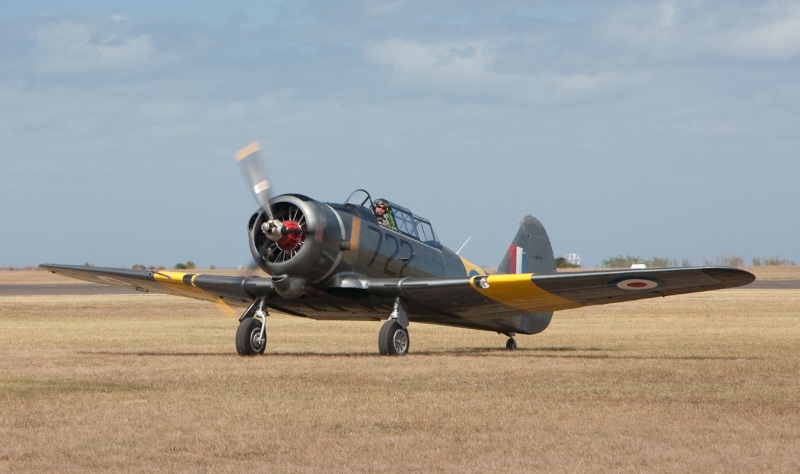
As it emerged, the "Wirra", as it was nicknamed, was armed with twin Vickers 7.7-millimeter machine guns in the cowling, and another Vickers gun on a flexible mount in the rear of the cockpit. It had underwing bomb racks, allowing it to carry four 45-kilogram (100-pound) or 115-kilogram (250-pound) bombs, or two 225-kilogram (500-pound) bombs. Four light bombs, such as smoke bombs, could be carried under the wing center section. It appears the back-seater could use a bombsight in the floor for level bombing, but it is uncertain if this feature was really useful. The Wirraway was powered by a PW S1H1-G Wasp radial with 450 kW (600 HP), built by CAC under license, and driving a three-bladed variable-pitch prop.
Following production of the 40 CA-1 machines, more batches of Wirraways were obtained, with successive designations including "CA-3" (60 built), "CA-5" (32), "CA-7" (100), "CA-8" (200), "CA-9" (188), and "CA-16" (135) -- for a total of 755 Wirraways built to end of production in 1946, of course not counting the pattern aircraft. There was little difference between the different variants, typically minor production changes. The CA-16 did add dive brakes and reinforcement for a heavier bomb load -- it is not clear that earlier variants could actually carry two 225-kilogram (500-pound) bombs.
Early in the war, the Wirraways were pressed into combat, being used for convoy protection. They took on Japanese bombers during the futile defense of Rabaul in the Solomons, and suffered heavily; they also fought, with little distinction, in the equally futile defense of Malaya.
By late 1942, however, the Wirraway had found its niche in the army cooperation role -- in modern terms, tactical support of troops in the bush, roles including reconnaissance, artillery spotting, light attack, message and supply dropping, plus the dropping of propaganda leaflets. The Wirraway was perfectly useful in such roles, its low performance being an asset in spotting, with a back-seat observer using binoculars to pick out targets. The "Basic Combat" concept worked perfectly well, at least in the right environment.
The Wirraway fought in the campaign to liberate New Guinea. Late in 1942 one enterprising pilot diving on a Japanese Nakajima Ki-43 fighter and, somewhat to his surprise, shot it down; it was the only "kill" the Wirraway ever performed. By mid-1943, the Wirraway had been generally relegated to the training role.
There were plans for a "CA-10" level bomber and a "CA-10A" dive bomber, but they didn't happen. In the postwar period, Wirraway trainers used by the Royal Australian Navy were designated "CA-20". Wirraways stayed in Australian military service to 1959. After retirement from military service, many Wirraways were converted to "CA-28 Ceres" agricultural aircraft, with a single-seat, raised cockpit placed to the rear, fixed landing gear, slats and bigger flaps, plus spray kit. A number of Wirraways survive today, including flying examples.
* The Wirraway having met expectations as a stopgap, the Australians considered what might be done to improve on it. The most powerful engine the Australians had available to them at the time was the 14-cylinder two-row air-cooled Pratt & Whitney R-1830-S3-CH6 Twin Wasp radial with 895 KW (1,200 HP), which was being license-built there to power Bristol Beaufort torpedo-bombers. Lawrence Wackett decided to mate a Twin Wasp to a strengthened and updated Wirraway, with a new front fuselage to accommodate the bigger engine, a single-seat cockpit, and armament of two 20-millimeter Hispano Mark II cannon and four 7.7-millimeter Browning machine guns. The pilot would be protected by seat armor and armor glass in a comfortable cockpit.
A contract for 105 of the fighters was issued in February 1942, and the first CA-12 flew on 29 May 1942, 16 weeks and three days after the formal beginning of the project. The end result was broadly similar to the NA-68 / P-64 single-seat fighter, but there was no collaboration with North American on the CA-12's design.
Like the NA-68, the CA-12 had a short fuselage and a single-seat cockpit, with a sliding canopy; unlike the NA-68, it had a redesigned forward fuselage to accommodate the bigger engine -- which drove a three-bladed prop -- and all the guns were in the wings. The big engine did give a poor forward view on the ground; there were also engine cooling problems at first, which were eventually fixed by modifying the engine installation.
The CA-12 was of mostly metal construction, with some wood assemblies, and fabric-covered flight surfaces. The cannon had 60 rounds per gun, while the machine guns had 1,000 rounds per gun. The CA-12 normally used a reflector gunsight, though it could be fitted with a ring-&-bead gunsight. Its external stores capability was the same as the Wirraway's, with one or two bombs under each wing, and four light stores on the wing center section. It could also carry a plywood centerline fuel tank.
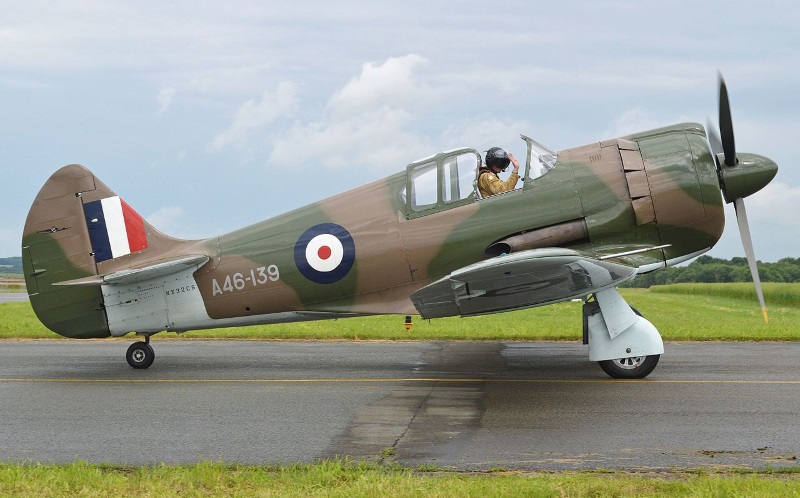
Trials going well, an order for 105 machines was placed, with the CA-12 acquiring the name of "Boomerang". Boomerangs were delivered to line units for operational training in October 1942. Top speed was unimpressive -- 480 KPH (300 MPH) max at altitude -- but the CA-12 had an excellent climb rate, good handling, and agility. Comparative trials against a Curtiss P-40 Kittyhawk and a Bell P-39 Airacobra showed that a competent pilot who understood what the CA-12 could and could not do was at no general disadvantage, and could readily turn the tables on an attacker.
___________________________________________________________________
CAC CA-12 BOOMERANG:
___________________________________________________________________
wingspan:
11 meters (36 feet 3 inches)
length:
7.77 meters (25 feet 6 inches)
height:
3.96 meters (13 feet)
empty weight:
2,440 kilograms (5,375 pounds)
max loaded weight:
3,450 kilograms (7,600 pounds)
maximum speed:
490 KPH (305 MPH / 265 KT)
service ceiling:
10,400 meters (34,000 feet)
range:
1,500 kilometers (930 MI / 810 NMI)
___________________________________________________________________
In practice, the Boomerang saw little air combat, replacing the Wirraway in the army cooperation role. It was also used for air-sea rescue, carrying an inflatable dinghy to drop to survivors.
Following production of the 105 CA-12s, CAC built 96 "CA-13" machines, which were generally similar -- the one noticeable difference being a spiny flame-damper exhaust, to reduce the aircraft's visibility in night combat. Other tweaks included a more powerful electrical system; metal-covered ailerons; wooden wingtips and pilot's seat; improved stick grip; and manual cocking of guns before take-off, the in-flight hydraulic cocking system used previously having proven unreliable.
Field crews devised a reconnaissance pack from the external tank, with a vertical and oblique camera. The lenses were covered with cardboard before take-off, with the pilot removing the covers with a string! One CA-13 was modified to carry an engineering observer scrunched-up in the rear fuselage. It sounds uncomfortable.
One of the CA-13s was taken off the assembly line, to be fitted with a General Electric turbocharger, scavenged from a Boeing B-17 bomber. The turbocharger was fitted in the rear fuselage, with the exhaust extended on the right side of the fuselage to drive the turbine, and a prominent airscoop for the turbocharger on the left side. The aircraft was designated "CA-14"; after trials from mid-1944, it was modified, primarily with a squared-off tailfin, and redesignated "CA-14A". Performance was significantly improved, with the machine reaching a top speed of 560 KPH (348 MPH) at altitude. However, the Aussies were obtaining plenty of Supermarine Spitfire fighters with better performance, and so the turbocharged Boomerang didn't go into production.
The third and last production batch of Boomerangs consisted of 49 "CA-19" machines, which were hard to tell from the CA-13, featuring only minor tweaks. Late-production machines had provision for mounting a Fairchild F24 reconnaissance camera in the rear fuselage. The last of 250 Boomerangs was rolled out in early 1945.
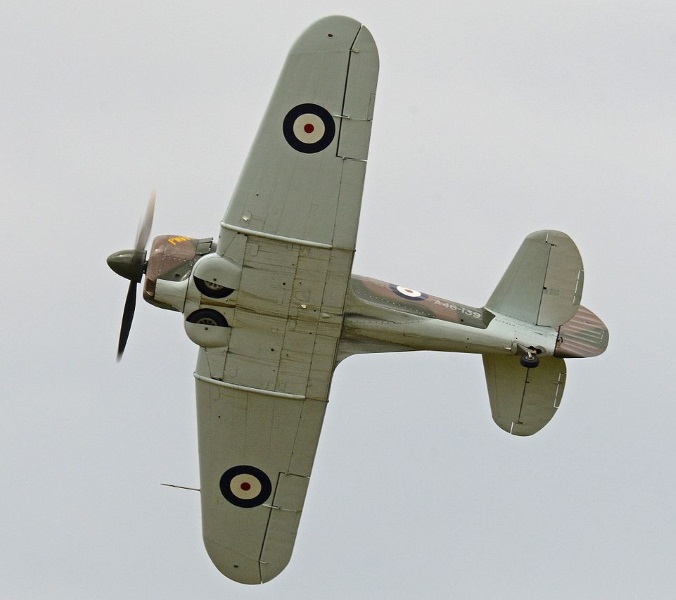
While some sources call the Boomerang a dismal failure, it was never intended as anything but a stopgap, and it proved itself all through the conflict. It was withdrawn with the end of the war, but a number have survived, including some flight-worthy examples. One alleged "Boomerang", however, is a modified Texan.
BACK_TO_TOP* Sources include:
* Illustrations details:
* Revision history:
v1.0.0 / 01 jun 19 v1.1.0 / 01 jul 19 / Clean-up release. v1.1.1 / 01 may 21 / Review & polish. v1.2.0 / 01 aug 22 / Review & polish. v1.2.1 / 01 apr 24 / Review & polish. (+)BACK_TO_TOP
